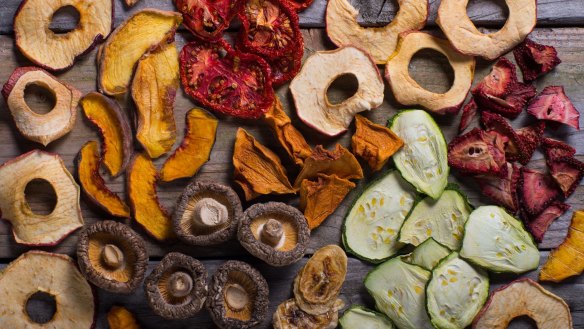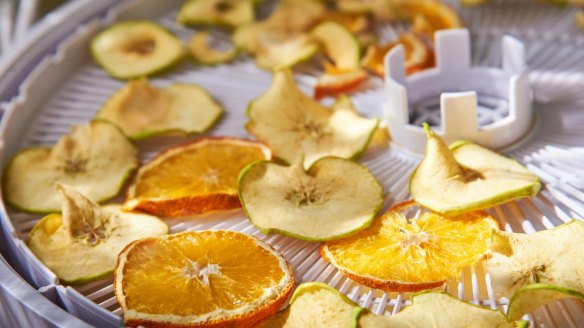Can't get cans? No freezer space? Discover the dark art of dehydration

Level with me. Is a small part of you secretly into prepping your cupboard for the apocalypse? I hear you. None of us wants to fear monger or build on a panic, but there's something primally satisfying about building yourself a DIY food store for a potential hibernation to come.

I know this, because last year (ah, remember last year?) I signed up to do a seven-day carry-everything-you-need hike, and discovered the dire world of living off non-refrigerated, lightweight meals. Despite healthy hikers setting out in droves into the wilderness each year, many rely on tuna sachets and instant pasta alfredo packs.
Cue an obsessive tumble into the world of DIY meal dehydrator. Over the course of a month I found that armed with a dehydrator or a bog standard oven, I could turn everything from rabbit cacciatore to vanilla rice pudding with poached rhubarb into just-add-water meals that keep for weeks, up to months, without refrigeration.
Now, as I watch the shelves empty of dried goods and cans, and hear people fret about freezer space, I've been able to keep calm and walk to the fresh food markets, safe in the knowledge that I can make close to any normal meal, from pumpkin curries to lamb tagines, dry them and lay them down in my cupboard.
And it just isn't difficult. It is stupidly easy. If you can make soup, and you own an oven, you can do it.
Eight smart tips for dehydrating
1. Let's start with the basics. What's happening here? By sucking the moisture from food you remove most of its weight and also one of the key conditions for bacteria to grow. Dehydrators start at about $100 and will make your world a lot easier as theyregulate their own temperature, airflow and time. But an oven will do. Set at 65C degrees. Most things take 6-10 hours. A vacuum sealer will condense the food for packing but will also make it far safer for long-term storage. Some hiking clubs have equipment libraries where they lend you the gear.
2. What can you dehydrate? Almost anything. I dried stews and soups, tagines, and bolognese. I now keep my own cup-a-soups in my desk. I pre-cooked then dehydrated rice and pasta so it only needed to be soaked and warmed rather than completely cooked on the trail, saving fuel. It also saves time if you do it at home. Fruit and vegetables can be dried as chips, pureed then sweetened and turned into leather, or just poached to gently rehydrate. You can even do dips such as hummus - just blend it back to powder after drying so it rehydrates with ease.
3. What can't you dry? Fat. It doesn't evaporate and can go rancid. Strip out all the fats you can while cooking (use less oil, blot it off from stews), then carry a tub of ghee, olive oil or coconut and milk powders and dried parmesan to add in on trail. It also means things like cheese and eggs don't work. Sorry.
4. Whatever you're drying, it needs to be spread thinly and evenly over a tray. No more than 5mm thick. A lot of blogs said this meant you needed minced meat, but anything cooked in a pressure cooker until it reaches a point where it can be shredded worked too. This made rabbit, chicken and lamb a possibility.
5. Bringing your dishes back from the dead is like witchcraft. The best rule of thumb is to add double the amount of water you need to rehydrate your dried dish. With rice, pastas and definitely chickpeas, which shrink to bullets, cover and soak them for an hour or overnight, then boil off the excess.
6. You don't have to go full DIY. Powdered eggs, flavoured well with herbs, parmesan and milk powder make an acceptable frittata. Supermarkets have surprisingly excellent powdered mousse and custard sachets for desserts. Asian grocers are treasure troves of miso sachets, crisp shallots, porcini mushrooms and preserved meats such as Chinese lap cheong. Buy that ramen, but turn it into mountain-top laksa or cook up easy fried rice.
7. Still too hard? Companies such as Outdoor Gourmet, Backcountry Cuisine, and Tasmania's new hero Strive (its laksa in particular, rates highly), sell freeze-dried meals from spaghetti bolognese to mi goreng and just-add-water berry cheesecakes for dessert. Rip off the top, add boiling water (or cold, depending), reseal and after 10-15 minutes, a rehydrated meal can be eaten straight from the bag.
8. What about booze? Tragically, there is no lightweight solution to booze unless you go for grappa, or Stroh, an 80 per cent rum that Dan Murphy's keeps locked away.
- More:
- Food
